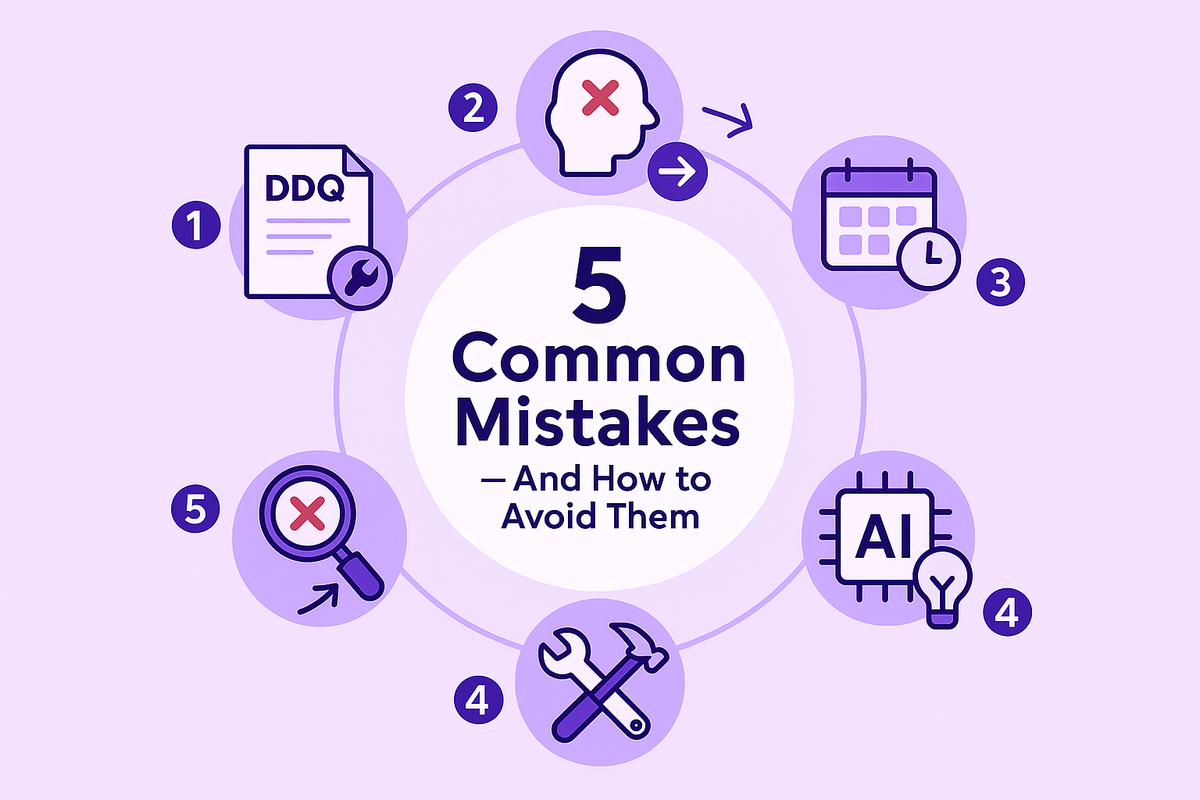DDQ Compliance: How to Answer Due Diligence Questionnaires
July 2, 2025
By
Evie Secilmis

5 Common Mistakes When Completing a DDQ (And How to Avoid Them)
Let's be real: a Due Diligence Questionnaire (DDQ) landing in your inbox can feel more like a pop quiz than an opportunity. The pressure is on to pull together perfect answers from legal, finance, and IT, all while a deadline looms. A poorly handled DDQ doesn't just look bad—it can raise red flags and jeopardize a major partnership. This is why solid ddq compliance is so critical. It’s not just about answering questions; it’s about proving your operational excellence and building trust from the start. A great response shows you're a transparent, reliable partner ready for business.
In this article, we’ll cover the five most common DDQ mistakes and how to avoid them so your firm can stand out for the right reasons.
What is a Due Diligence Questionnaire (DDQ)?
Before we jump into the common mistakes, let's get clear on the fundamentals. A Due Diligence Questionnaire (DDQ) is a formal document companies use to vet a potential partner, vendor, or investment target. Think of it as an exhaustive, written interview designed to get a comprehensive look under the hood of another business. The main goal is to gather specific, detailed information to identify and evaluate potential risks before you sign on the dotted line. It’s a structured way to ensure you know exactly what you’re getting into, making it a fundamental part of any smart business decision.
The Core Purpose: More Than Just a Formality
While it might feel like just another stack of paperwork, a DDQ is a critical risk management tool. Its main job is to help you methodically find and understand risks before you commit to a partnership. By asking targeted questions, you can uncover potential liabilities, operational weaknesses, or compliance gaps that aren't obvious from public documents. This isn't about playing "gotcha"; it's about fostering transparency and building a foundation of trust. To protect the sensitive details being shared, the process almost always starts with signing a Non-Disclosure Agreement (NDA), which gives the responding company the confidence to share information openly.
Completing a DDQ is a team sport. Because the questions span so many topics, you'll need input from financial analysts, legal counsel, IT specialists, and operations teams. Each expert provides their piece of the puzzle to create a complete and accurate picture. However, coordinating this effort and standardizing information from different departments can be a huge time drain. This is where having a centralized knowledge base becomes invaluable. An AI-powered platform like HeyIris.ai can act as your single source of truth, pulling verified information instantly and ensuring your responses are consistent and up-to-date, no matter who is contributing.
When Are DDQs Used?
DDQs show up in any business scenario that requires a serious level of vetting. In mergers and acquisitions (M&A), they are non-negotiable. A buyer uses a DDQ to fully understand the target company’s finances, contracts, and hidden liabilities to avoid any post-deal surprises. They are also essential for vendor and third-party vetting. Before you bring on a new software provider or supplier, a DDQ helps you assess their data security, financial stability, and compliance, ensuring they won't become a weak link in your operations. This proactive check is a critical part of modern risk management and protects your business from potential disruptions.
Investment and financial transactions are another key area where DDQs are standard practice. Venture capitalists, private equity firms, and other investors use them to scrutinize a company's business model, management team, and market position before committing capital. A well-prepared DDQ can build investor confidence and is often the key to securing funding. Increasingly, these questionnaires also include sections on Environmental, Social, and Governance (ESG) factors, as investors want to check a company's practices on corporate responsibility. Understanding these common use cases helps you anticipate when a DDQ is coming and prepare your documentation in advance.
Key Areas Covered in a DDQ
A DDQ is designed to be comprehensive, touching on nearly every aspect of a business. While specific questions vary, they usually fall into a few key categories. Financial health is always front and center, with deep dives into your financial statements, revenue projections, and debt structure to confirm your stability. The legal and compliance section is just as critical, aiming to uncover any ongoing litigation or regulatory issues. Inquirers want to make sure the company follows all relevant laws, from data privacy rules like GDPR to anti-corruption policies, so they aren’t inheriting unforeseen legal risks.
Cybersecurity and data protection are also top priorities. Expect detailed questions about your IT infrastructure, security protocols, and incident response plans to prove you can protect sensitive data. The operations and business continuity section examines your day-to-day processes, organizational structure, and disaster recovery plans to ensure you’re a well-managed and resilient partner. Finally, Environmental, Social, and Governance (ESG) criteria are now a standard part of most DDQs. This section assesses your performance on corporate responsibility, from your environmental impact to your diversity and inclusion policies, giving a more holistic view of your company's long-term viability and ethical standing.
Why Your DDQ Response Can Make or Break a Deal
A DDQ (Due Diligence Questionnaire) is a standardized document used by investors and clients to evaluate a firm’s financial stability, compliance practices, and operational processes. In essence, DDQs serve as a transparency tool:
- They provide insight into a firm’s operational and financial health.
- They highlight compliance with industry standards and regulations.
- They build trust with investors and clients by demonstrating readiness and accountability.
A thoughtful, complete, and accurate DDQ not only improves credibility but also helps differentiate your firm in a competitive market.
Common Pitfall #1: Are You Giving Incomplete Answers?
The problem: Missing data, vague responses, or incorrect details erode confidence in your firm’s attention to detail. Investors may question your reliability or reject your DDQ outright.
How to avoid it:
- Review every section thoroughly.
- Cross-check information against internal records.
- Use a checklist to ensure no questions are skipped.
- Implement a final review process by senior team members.
- Offer DDQ training to employees to emphasize accuracy.
Common Pitfall #2: Stop Using Generic, Copy-Pasted Answers
The problem: Many firms recycle the same boilerplate answers across all DDQs. This signals a lack of personalization and suggests you’re not considering the unique needs of each client.
How to avoid it:
- Customize answers based on the client’s industry, size, and objectives.
- Highlight how your firm addresses their specific challenges.
- Research the client’s business model and tailor responses accordingly.
Tailored responses show genuine interest and position your firm as a partner—not just a vendor.
Common Pitfall #3: Ignoring DDQ Automation Tools
The problem: Manual DDQ processes are time-consuming and prone to human error. They slow down responses, increase workload, and put your firm at a disadvantage.
How to avoid it:
- Invest in DDQ automation software that streamlines data collection and response management.
- Use tools that ensure consistency, reduce errors, and centralize updated information.
- Train your team to maximize the value of automation.
Modern DDQ tools often include analytics, version tracking, and collaboration features that make the entire process more efficient.
The Role of Virtual Data Rooms (VDRs)
Think of a Virtual Data Room (VDR) as a highly secure, digital filing cabinet built specifically for sensitive business transactions. When you’re handling a DDQ, you’re sharing confidential information, and a VDR provides a controlled environment to do so. Instead of emailing attachments back and forth, you grant stakeholders access to a centralized space where all necessary documents are organized. Modern VDRs have greatly improved how DDQs are handled by automatically organizing files and even using AI to find important information, which saves a tremendous amount of time. This not only streamlines the process but also gives you an audit trail of who accessed what and when, adding a critical layer of security and compliance.
How AI-Powered Platforms Accelerate Responses
While VDRs are excellent for managing documents, AI-powered response platforms take efficiency a step further. These tools are designed to help you answer DDQs and other questionnaires faster by intelligently organizing your company’s information. Instead of just storing files, they create a dynamic knowledge library that can suggest answers to common questions. For teams buried in RFPs, RFIs, and DDQs, this is a game-changer. An AI platform can generate a complete first draft in minutes, freeing up your experts to focus on refining and tailoring the responses. This shift from manual searching to automated drafting dramatically shortens your sales cycle and improves the quality of your submissions.
Centralized Document Management
One of the biggest headaches in the DDQ process is tracking down the right information. It’s often scattered across different departments, stored in various folders, or hidden in old email threads. An AI-powered platform solves this by creating a single source of truth. It connects to your existing systems—like SharePoint, Google Drive, and Confluence—to keep all the information and supporting documents in one central place. Platforms like Iris even take it a step further by proactively identifying and flagging outdated content across your systems, ensuring your team always uses the most current and accurate information. This eliminates inconsistencies and reduces the risk of providing incorrect data to potential partners or investors.
Streamlined Q&A Workflows
Completing a DDQ is rarely a one-person job. It requires input from subject matter experts across legal, finance, IT, and operations. Coordinating this collaboration can quickly become chaotic. AI platforms bring order to this process with streamlined Q&A workflows. You can assign specific questions to the right team members, track their progress in real-time, and manage approvals all within the platform. This eliminates endless email chains and version control issues. Furthermore, these systems keep detailed records of all activity, creating a clear audit trail that demonstrates a structured and compliant response process. It turns a frantic, manual effort into a smooth, collaborative, and reportable operation.
Common Pitfall #4: The Risk of Stale Information in DDQ Compliance
The problem: Outdated financial data, compliance measures, or staffing details can create discrepancies and compliance risks.
How to avoid it:
- Set a regular review schedule for all DDQ content.
- Assign a dedicated owner for keeping information current.
- Conduct periodic audits to identify gaps or outdated details.
Being proactive ensures your DDQ is always accurate and reduces last-minute scrambles.
Using Frameworks like NIST and ISO 27001 to Stay Prepared
One of the most effective ways to keep your information fresh and ready for scrutiny is by adopting established industry frameworks. Standards like NIST and ISO 27001 provide a structured approach for regularly reviewing your cybersecurity and operational practices, ensuring your documented procedures are always current. When you consistently check your cybersecurity against these benchmarks, you’re essentially pre-answering entire sections of future DDQs. This proactive stance turns the due diligence process from a reactive chore into a strategic advantage, allowing you to demonstrate operational excellence and build a strong foundation of trust with potential partners.
Common Pitfall #5: Letting Team Miscommunication Derail Your DDQ
The problem: Without clear communication, internal teams may provide inconsistent or incomplete information, leading to delays and errors in the DDQ submission.
How to avoid it:
- Create structured communication protocols.
- Involve all relevant departments in the DDQ process.
- Assign a single point of contact for questions and clarifications.
- Use collaboration tools to centralize information.
Strong communication ensures every stakeholder is aligned and working with the latest data.
Your Next Steps for a Better DDQ Process
Completing a DDQ doesn’t have to be daunting. By avoiding these five mistakes—incomplete answers, generic responses, lack of automation, outdated data, and poor communication—your firm can submit DDQs that are accurate, personalized, and compelling.
Leveraging technology, maintaining updated information, and fostering internal alignment will make your DDQ process more efficient and effective. In turn, this improves your reputation with investors and boosts your chances of winning new partnerships.
Key Takeaways
- Accuracy matters: Double-check every response before submission.
- Personalization builds trust: Tailor your DDQ answers to each client.
- Technology is your ally: Use automation to reduce errors and save time.
- Stay current: Regularly update your DDQ data and processes.
- Communicate clearly: Keep stakeholders aligned from start to finish.
Adopt a Risk-Based Approach to Prioritization
Not all questions in a DDQ carry the same weight. Some are simple administrative checks, while others dig into high-stakes areas like cybersecurity, data privacy, and financial stability. A risk-based approach helps you focus your team’s time and energy on the questions that matter most. This means prioritizing responses that address the greatest potential risks to the client or your own business. By tackling these critical sections first, you ensure your most important information is thoroughly vetted and accurately presented, which is key for effectively managing risks and showing you’re compliant.
This strategic approach does more than just streamline your workflow—it can become a competitive advantage. When you address a potential partner’s biggest concerns with clear, confident answers, you build trust and show that your firm is prepared for whatever comes next. Investing in solid DDQ processes and technology makes all the difference here. For instance, using a centralized knowledge library, often managed by an AI deal desk solution, ensures your answers to these high-risk questions are always consistent, accurate, and ready to go. This proactive stance shows you’re not just checking a box; you’re proving you’re a reliable and secure partner.
Frequently Asked Questions
Our DDQ process is a total mess. Where do we even start to fix it? The best first step is to create a centralized knowledge library. Don't try to boil the ocean. Just gather your most recent DDQ responses and pull the best answers into a single master document. From there, identify the go-to expert in your company for each type of question—like legal, finance, and IT—and have them review only their relevant sections. This simple audit creates a solid foundation you can build on, turning chaos into a reliable resource for your next DDQ.
Is investing in a DDQ automation tool really worth it for a smaller team? Absolutely. For smaller teams, time is your most precious resource. Manually chasing down answers and copy-pasting from old documents is a huge time drain that pulls you away from revenue-generating activities. An automation tool acts as a force multiplier, allowing a lean team to respond quickly and accurately without burning out. Think of it less as an expense and more as an investment in efficiency that lets you compete with larger, better-resourced companies.
Who should ultimately be in charge of the DDQ response process? While completing a DDQ is always a team effort, it’s essential to have one person act as the project manager or "quarterback." This individual doesn't need to be the expert on every topic, but they are responsible for assigning questions, tracking deadlines, and ensuring the final submission is consistent and polished. This role often falls to someone in sales operations or proposal management, as they have the visibility to coordinate across different departments effectively.
What's the best way to answer a question if we don't have a formal policy in place yet? Honesty is always the best policy. Never invent an answer or leave a critical question blank. Instead, be transparent about your current status. You can state that a formal policy is under development and provide a timeline for its completion. This shows you are proactive and take the issue seriously, which can build more trust than pretending to have everything figured out.
How often should we be updating our master DDQ content? A good rule of thumb is to schedule a formal review of your entire knowledge library on a quarterly basis. This ensures most of your standard information stays fresh. However, certain high-stakes information, such as financial data, security protocols, or key personnel changes, should be updated immediately as they happen. Setting these regular check-ins prevents the last-minute scramble to fix outdated information when a deadline is looming.
Related Articles
Share this post
Link copied!





















